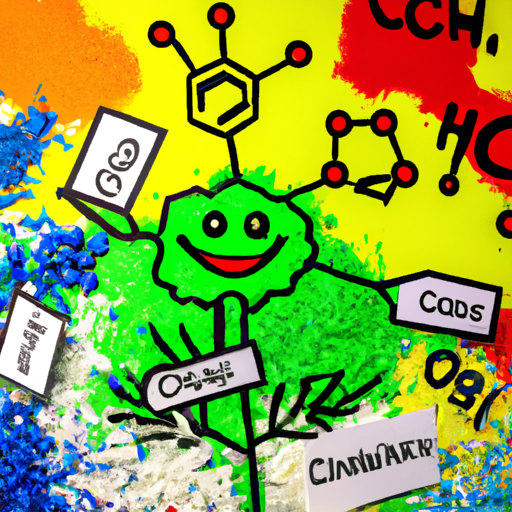Welcome to the captivating world of cannabis and science! In this article, we embark on an enlightening journey to explore the science behind cannabis, uncovering its potential benefits, risks, and untapped possibilities. From the intricate chemistry of cannabinoids, terpenes, and other compounds to the therapeutic potential of cannabis for various health conditions, we delve into the fascinating realm of this remarkable plant.
Section 1, "Unveiling the Chemistry of Cannabis: Understanding the Complex Interactions of Cannabinoids, Terpenes, and Other Compounds," takes us deep into the molecular intricacies of cannabis. We unravel the complex interactions between cannabinoids, terpenes, and other compounds, shedding light on how they work together to produce the desired effects. Through the latest research and studies, we gain a comprehensive understanding of the chemistry behind cannabis, exploring its diverse array of compounds and their potential implications.
In Section 2, "Exploring the Therapeutic Potential of Cannabis: Unlocking its Benefits for Various Health Conditions," we embark on an exploration of the therapeutic potential of cannabis. With a focus on the latest scientific findings, we uncover the potential benefits of cannabis for a range of health conditions. From pain management to anxiety and beyond, we delve into the research that supports the use of cannabis as a potential treatment option, providing insights into its efficacy and safety.
Section 3, "Navigating the Science of Cannabis: Dosage, Strain Selection, and Delivery Methods for Optimal Results," equips you with the knowledge to navigate the world of cannabis with confidence. We delve into the science behind dosage, strain selection, and delivery methods, shedding light on how to achieve optimal results when using cannabis. Whether you're a novice or a seasoned user, this section provides valuable insights to enhance your cannabis experience.
Join us on this thrilling journey as we navigate the cutting-edge research, breakthrough discoveries, and emerging applications of cannabis. By the end of this article, you'll be empowered with knowledge and insights into the fascinating world of cannabis and its scientific possibilities. Get ready to explore the captivating realm where cannabis and science intertwine, uncovering the true potential of this extraordinary plant.
Keywords: Cannabis, science, benefits, risks, potential, plant, cannabinoids, terpenes, therapeutic, health conditions, dosage, strain selection, delivery methods, research, studies, chemistry, interactions, discoveries, applications, scientific possibilities.
- 1. "Unveiling the Chemistry of Cannabis: Understanding the Complex Interactions of Cannabinoids, Terpenes, and Other Compounds"
- 2. "Exploring the Therapeutic Potential of Cannabis: Unlocking its Benefits for Various Health Conditions"
- 3. "Navigating the Science of Cannabis: Dosage, Strain Selection, and Delivery Methods for Optimal Results"
1. "Unveiling the Chemistry of Cannabis: Understanding the Complex Interactions of Cannabinoids, Terpenes, and Other Compounds"

Unveiling the Chemistry of Cannabis: Understanding the Complex Interactions of Cannabinoids, Terpenes, and Other Compounds
When it comes to cannabis, there is so much more than meets the eye. Beyond its vibrant green leaves and pungent aroma, this remarkable plant holds a world of scientific wonders waiting to be explored. With advancements in research and studies, we are beginning to unravel the intricate chemistry behind cannabis and its various components.
At the heart of cannabis are cannabinoids, the chemical compounds that interact with our body's endocannabinoid system. The most well-known cannabinoid is tetrahydrocannabinol (THC), responsible for the psychoactive effects often associated with cannabis. However, there are over 100 other cannabinoids present in the plant, each with its own unique properties and potential benefits.
In addition to cannabinoids, cannabis also contains terpenes, aromatic compounds that contribute to the plant's distinct smell and taste. These terpenes not only enhance the overall sensory experience but also play a crucial role in the entourage effect, the synergistic interaction between cannabinoids and terpenes that may enhance the therapeutic potential of cannabis.
The complex interactions between cannabinoids, terpenes, and other compounds in cannabis create a wide array of effects and potential benefits. Research suggests that cannabinoids like cannabidiol (CBD) have anti-inflammatory, analgesic, and neuroprotective properties, making them promising candidates for the treatment of various health conditions such as chronic pain, epilepsy, and anxiety.
Understanding the chemistry of cannabis is also vital in determining the optimal dosage, strain selection, and delivery methods. Different strains of cannabis contain varying levels of cannabinoids and terpenes, which can result in different effects. By knowing the chemical composition of a particular strain, individuals can make informed choices based on their desired outcomes.
Moreover, the way cannabis is consumed can also influence its effects. Whether it's smoking, vaporizing, or using edibles, the method of delivery affects how cannabinoids are absorbed by the body and how quickly they take effect. This knowledge allows individuals to tailor their cannabis experience to their specific needs and preferences.
As research continues to unfold, we are discovering new applications and possibilities for cannabis. From exploring its potential in pain management, cancer treatment, and mental health to uncovering its role in neuroprotection and anti-aging, the scientific community is continuously pushing the boundaries of our understanding.
In conclusion, the chemistry of cannabis is a fascinating realm that holds immense potential. By delving into the intricate interactions of cannabinoids, terpenes, and other compounds, we gain valuable insights into the benefits, risks, and untapped possibilities of this versatile plant. Through research, studies, and scientific exploration, we are paving the way for a future where cannabis can be utilized to improve health and well-being in a safe and informed manner. So join us as we embark on this journey into the world of cannabis science, where the possibilities are endless and the discoveries are just beginning.
2. "Exploring the Therapeutic Potential of Cannabis: Unlocking its Benefits for Various Health Conditions"

Exploring the Therapeutic Potential of Cannabis: Unlocking its Benefits for Various Health Conditions
Cannabis has long been used for its medicinal properties, and recent scientific research has only bolstered its reputation as a powerful therapeutic tool. The potential benefits of cannabis for various health conditions are vast, and ongoing studies continue to shed light on its effectiveness.
One of the key components of cannabis that contributes to its therapeutic potential is cannabinoids. These are chemical compounds found in the plant that interact with our body's endocannabinoid system, which plays a crucial role in regulating various physiological processes. The most well-known cannabinoids in cannabis are THC (tetrahydrocannabinol) and CBD (cannabidiol), each with its own unique effects and potential benefits.
Research has shown that cannabis and its cannabinoids may have a multitude of therapeutic applications. For example, CBD has been found to have anti-inflammatory properties and may be beneficial in managing conditions such as arthritis and chronic pain. It has also shown promise in reducing anxiety and improving sleep.
THC, on the other hand, is known for its psychoactive effects, but it also has potential therapeutic benefits. It has been found to be effective in managing nausea and vomiting in cancer patients undergoing chemotherapy, as well as stimulating appetite in individuals with appetite loss due to conditions like HIV/AIDS.
In addition to cannabinoids, cannabis contains other compounds such as terpenes, which contribute to its therapeutic effects. Terpenes are aromatic compounds responsible for the distinct smells and flavors of different cannabis strains. They also have their own potential therapeutic benefits. For example, the terpene linalool, found in lavender and some cannabis strains, has been found to have anti-anxiety and sedative properties.
When it comes to utilizing the therapeutic potential of cannabis, dosage, strain selection, and delivery methods play crucial roles. Different conditions may require different dosages and strains with specific cannabinoid and terpene profiles. For example, a strain high in CBD and low in THC may be more suitable for managing pain, while a strain with a higher THC content may be beneficial for managing symptoms of certain neurological conditions.
Delivery methods also vary, with options such as smoking, vaporizing, and consuming edibles. Each method has its own onset time and duration of effects, which should be considered when using cannabis for therapeutic purposes.
It's important to note that while cannabis shows promise as a therapeutic agent, further research is still needed to fully understand its potential benefits, risks, and optimal usage. As the scientific community continues to explore the intricacies of cannabis and its interactions with the human body, we can expect more breakthrough discoveries and applications in the future.
In conclusion, the therapeutic potential of cannabis for various health conditions is a topic of great interest and ongoing research. With its diverse array of cannabinoids, terpenes, and other compounds, cannabis offers a wide range of potential benefits. By delving into the science behind cannabis and staying informed about the latest research and studies, we can unlock its true potential and harness its therapeutic power for the betterment of human health.
3. "Navigating the Science of Cannabis: Dosage, Strain Selection, and Delivery Methods for Optimal Results"

Navigating the Science of Cannabis: Dosage, Strain Selection, and Delivery Methods for Optimal Results
When it comes to cannabis, understanding the science behind dosage, strain selection, and delivery methods is crucial for achieving optimal results. The diverse range of cannabinoids, terpenes, and other compounds found in cannabis interact with our bodies in unique ways, and it's important to navigate this intricate chemistry to ensure we harness the full potential of the plant.
Dosage plays a vital role in cannabis consumption. The right dosage can make the difference between experiencing the therapeutic benefits of cannabis and potentially encountering unwanted side effects. It's essential to start with a low dose and gradually increase it until the desired effects are achieved. This allows individuals to find their ideal dosage and minimize the risk of adverse reactions.
Strain selection is another key consideration when exploring the science of cannabis. Different strains possess varying levels of cannabinoids and terpenes, which contribute to their unique effects. Understanding the specific properties of different strains can help individuals tailor their cannabis experience to their desired outcomes. For example, some strains may be more suitable for relaxation and stress relief, while others may be better for boosting creativity and focus.
Delivery methods also play a significant role in the experience and effectiveness of cannabis consumption. The method of delivery determines how cannabinoids and other compounds are absorbed by the body. Common delivery methods include smoking, vaporizing, edibles, tinctures, and topicals. Each method has its advantages and considerations, such as onset time, duration of effects, and bioavailability. By understanding the science behind these delivery methods, individuals can choose the one that best suits their needs and preferences.
Research and studies continue to shed light on the intricate chemistry and potential applications of cannabis. Scientists are uncovering new insights into how cannabinoids and terpenes interact with our endocannabinoid system, which plays a crucial role in regulating various physiological processes. This knowledge opens up exciting possibilities for developing targeted cannabis-based therapies for specific health conditions.
In conclusion, navigating the science of cannabis is essential for harnessing its benefits, understanding the risks, and exploring its untapped potential. Dosage, strain selection, and delivery methods all contribute to the overall cannabis experience and can significantly impact the results. By staying informed about the latest research and discoveries, individuals can make informed decisions and unlock the scientific possibilities of this remarkable plant.
